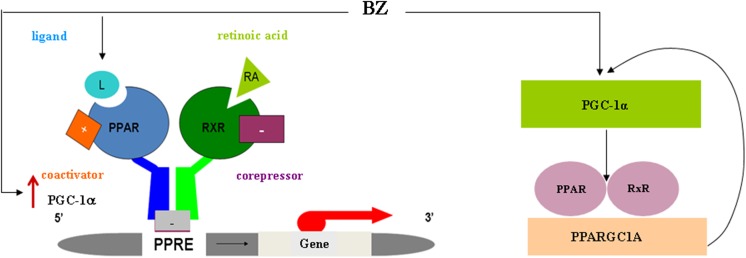Fig. 9.
The role of BZ in the PPARA/RXRA ligand-dependent (PPARAGC1A) gene transcription regulation. As a transcription factor, peroxisome proliferator-activated receptor alpha (PPAR-alpha) encoded by the PPARA gene regulates transcription of PPAR response element-containing promoter genes after heterodimerization with retinoid X receptor alpha (RXRA). The complex of PPARA/RXRA binds to specific regions on the DNA of target genes. The DNA consensus sequence of peroxisome proliferator hormone response elements (PPRE) is AGGTCANAGGTCA, with N being any nucleotide. The function of PPAR-alpha is modulated by ligands and by a number of coactivator and corepressor proteins. Upon PPARA/RXRA complex binding into the ligand-binding domain, transcription of target genes is up- or downregulated. Negative regulation of PPARA/RXR transcription activity is related to recruitment of the transcriptional corepressors (for example, NCoR and SMRT), while positive activation is related to recruitment inter alia PGC1α coactivator encoded by PPARGC1A gene. In this molecular mechanism, retinoic acid plays a role of the major selective agonist of the endogenous mammalian RXR receptor, while BZ plays a role of the ligand that binds to a PPAR-α receptor. BZ as an agonist of PPARα upregulates activity of this receptor and induces PPARGC1A gene transcription, which in positive feedback mechanism further stimulates the system. BZ can upregulate PPARGC1A transcription on dependent and independent pathways from PPARA/RXRA complex. See text for the references

